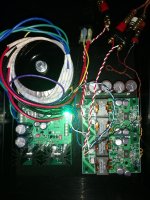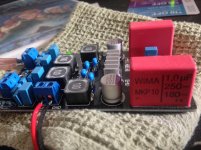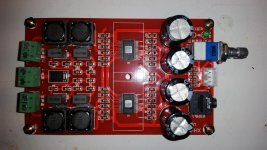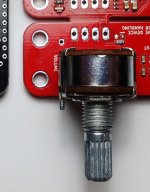Red = RCA+
Brown = RCA GND
Black = chassis ground
White = chassis ground
Yellow = amp input signal+
Orange = amp input signal-
Trying now, unfortunately, it doesn't eliminate the hum. Here are a few observations:
- The white leads (input transformer case/shielding) don't appear to make a difference whether they are left floating or connected to chassis ground.
- The black leads (transformer ground?) change the pitch of the hum when tied to chassis ground, ever so slightly. Doesn't seem to make a difference in the loudness of the hum.
- The black leads tied to signal ground on the amp board definitely make the hum louder/worse.
- The black leads tied to RCA ground don't make a difference.
- I noticed that when the source is not connected, the hum gets dramatically louder (regardless of black/white wire config).
Here's an obligatory bad cell phone pic, in case anyone sees any obvious problems. The Jensen input transformers are underneath the amp boards.
Attachments
The audio transformers seem quite close to the power transformer. The power transformer leads should be twisted tightly and made as short as possible - both the primaries (red and black) and secondaries (green and blue) could be made much shorter and twisted tightly. I'd rotate the mains transformer to enable the leads to be cut as short as possible, then experiment with rotating the audio transformers (often thus will reduce/remove hum from).
Trying now, unfortunately, it doesn't eliminate the hum. Here are a few observations:
- The white leads (input transformer case/shielding) don't appear to make a difference whether they are left floating or connected to chassis ground.
- The black leads (transformer ground?) change the pitch of the hum when tied to chassis ground, ever so slightly. Doesn't seem to make a difference in the loudness of the hum.
- The black leads tied to signal ground on the amp board definitely make the hum louder/worse.
- The black leads tied to RCA ground don't make a difference.
- I noticed that when the source is not connected, the hum gets dramatically louder (regardless of black/white wire config).
Here's an obligatory bad cell phone pic, in case anyone sees any obvious problems. The Jensen input transformers are underneath the amp boards.
I see some lines going from the power transformer (black) towards the audio input. Generally you want to isolate your power ground from your signal ground. I assume that the DUG amp has as standard, differential inputs. If using single ended (non differential) inputs then the negative of the input should be jumpered to ground (via a tiny piece of wire to the closest ground point or ground plane). But if you are using differential inputs like balanced inputs from a signal transformer, the leads from the transformer should not connect to the ground from the transformer (power supply). If you use an ohm meter between any lead of the input to power ground - there should not be a short. It should be "open" circuit.
Also, I see your input transformer appears to be located far away outside of picture and going through RCA jacks to thin twisted wide. You need to move transformer inside box and solder output leads straight to board as close as possible (a couple of inches max). If you need to locate it farther away - use shielded coax like RG174 but don't ground shield to power supply - only to source.
Hope this helps - you definitely have a ground loop - and it is contaminating your balanced inputs.
One other thing to try is to disconnect the earth ground from power transformer temporally to see if him stops.
What do you guys think if TDA7498 vs 3116/3118?
the cheap black 7498 is serious competition to any single supply class d board.
i remember that moment in summer when we had two big bl-horns with visaton bg20 outside.
when i switched the 3116 for the 7498 everybody was like:
‘i thought the sound was good before.
but now i realize how bad it actually was.'
I see some lines going from the power transformer (black) towards the audio input.
Which lines are you talking about? The thick black wires (left hand side) are power transformer primary leads. Those go straight to the IEC, not connected to anything else (but should be twisted, as Sharpi31 mentioned).
I suspect you're talking about the thin black wires (right hand side). Those are the black leads from the Jensen JT-11P-1 input transformers. In the picture, they are tied to the white leads from the input transformers, and also to the blue-and-white twisted wires. The blue-and-white twisted wires don't go to the power transformer, they go to the chassis ground. You can't see it in the picture, but right near the left-hand edge of the chassis, between the power transformer and power supply PCB is a bolt screwed into the chassis for chassis ground.
That bolt connects the following: white and black leads from the input transformers (as mentioned above), the purple lead from the power transformer (shielding/screen), and the yellow lead from the IEC (earth).
Generally you want to isolate your power ground from your signal ground. I assume that the DUG amp has as standard, differential inputs. If using single ended (non differential) inputs then the negative of the input should be jumpered to ground (via a tiny piece of wire to the closest ground point or ground plane). But if you are using differential inputs like balanced inputs from a signal transformer, the leads from the transformer should not connect to the ground from the transformer (power supply). If you use an ohm meter between any lead of the input to power ground - there should not be a short. It should be "open" circuit.
Source signal is single-ended, but I am using Jensen JT-11P-1 line-level transformers to convert to balanced input to the DUG-1 amps. The input transformers are under the DUG boards, so you can't see them in the picture.
When you say "power ground", do you mean the "cold"/0V lead coming from the DC supply? Or the IEC's safety earth (3rd prong)? Or chassis ground (which is tied to safety earth)? Or something else?
Also, I see your input transformer appears to be located far away outside of picture and going through RCA jacks to thin twisted wide. You need to move transformer inside box and solder output leads straight to board as close as possible (a couple of inches max).
The input transformers are "hiding" under the amp boards. 🙂 But the leads are longer than necessary, no doubt about that.
That is one complaint about the JT-11P-1 transformers: the leads are tiny (32 AWG stranded), and connect inside the mu-metal casing. I.e., I don't think I could replace them easily. That's why I was initially hesitant to cut them down to length, I wanted to ensure everything was working properly first. In hindsight I probably should have bought the PCB mount version of these transformers, but these leaded ones were much cheaper through Markertek.
Hope this helps - you definitely have a ground loop - and it is contaminating your balanced inputs.
One other thing to try is to disconnect the earth ground from power transformer temporally to see if him stops.
Thanks, Xrk. I agree, it's a "classic" ground loop. Just need to find and eliminate it.
I will keep plugging away, you and Sharpi31 have given me some good ideas to try. Thanks again gents!
The old hidden under the PCB trick... 🙂
One last debugging thing to try... separate the toroidal transformer and rectifier/cap bank from amp boards by 2 to 3 ft to make sure it't not some EM field contamination that is inducing hum. Try a SMPS brick to see if hum goes away.
One time I switched from a 3-prong grounded SMPS to a 2-prong ungrounded and hum went away.
One last debugging thing to try... separate the toroidal transformer and rectifier/cap bank from amp boards by 2 to 3 ft to make sure it't not some EM field contamination that is inducing hum. Try a SMPS brick to see if hum goes away.
One time I switched from a 3-prong grounded SMPS to a 2-prong ungrounded and hum went away.
I know I'm late to the party, and there are better boards available, but I wanted to tweak a little and learn more than I would by just plugging in a stock amp. However, after making the above changes and comparing it to a stock board I am really not hearing any differences. These are playing through Altec Lansing Model19s, which I think can be considered a revealing speaker. The amps sound ok, but as others have noted, can be shrill and shouty especially on female vocals. In addition to the above changes I have some of the Bourns inductors on the way, and was thinking about a snubber mod as well.
I have yet to put them on a power supply other than a couple smps, 12v 12amp xbox360 supply/19.5v 4a laptop/12v 3a wall wart w a bank of caps on the supply. Again no difference detected in sound. I'm thinking about an Astron but am having second thoughts now.
The only thing I have found to make an appreciable difference was using it with a tube Mcintosh preamp on loan from a friend, wow, nice! This makes me think maybe I'd be better off just getting a sainsmart 2 or 3 tube pre as PG and several others have used with glowing reviews.
Any recommends? Start over with a different 3116 board? Finish my mods and keep going with pre and Astron? I love to tinker but would like more of a payoff in sound quality for my efforts.
I have yet to put them on a power supply other than a couple smps, 12v 12amp xbox360 supply/19.5v 4a laptop/12v 3a wall wart w a bank of caps on the supply. Again no difference detected in sound. I'm thinking about an Astron but am having second thoughts now.
The only thing I have found to make an appreciable difference was using it with a tube Mcintosh preamp on loan from a friend, wow, nice! This makes me think maybe I'd be better off just getting a sainsmart 2 or 3 tube pre as PG and several others have used with glowing reviews.
Any recommends? Start over with a different 3116 board? Finish my mods and keep going with pre and Astron? I love to tinker but would like more of a payoff in sound quality for my efforts.
Attachments
Last edited:
I know I'm late to the party, and there are better boards available, but I wanted to tweak a little and learn more than I would by just plugging in a stock amp. However, after making the above changes and comparing it to a stock board I am really not hearing any differences. These are playing through Altec Lansing Model19s, which I think can be considered a revealing speaker. The amps sound ok, but as others have noted, can be shrill and shouty especially on female vocals. In addition to the above changes I have some of the Bourns inductors on the way, and was thinking about a snubber mod as well.
I have yet to put them on a power supply other than a couple smps, 12v 12amp xbox360 supply/19.5v 4a laptop/12v 3a wall wart w a bank of caps on the supply. Again no difference detected in sound. I'm thinking about an Astron but am having second thoughts now.
The only thing I have found to make an appreciable difference was using it with a tube Mcintosh preamp on loan from a friend, wow, nice! This makes me think maybe I'd be better off just getting a sainsmart 2 or 3 tube pre as PG and several others have used with glowing reviews.
Any recommends? Start over with a different 3116 board? Finish my mods and keep going with pre and Astron? I love to tinker but would like more of a payoff in sound quality for my efforts.
That is a second generation "clone" of the original Danzz blue/black board (has LED). I think these for some reason are not as good as the originals. In any case, surprised you did not hear a difference with 330uF SEPF's. Swap the 1uF WIMA's for 3.3uF or 4.7uF and that should improve bass. Bootstrap snubber mod is also very worthwhile to try.
Move onto Sanwu 3118 PBTL monoblocks and mod the gain resistors. That amp sounds very nice. Also give Sanwu TDA8932 monoblock a try. Bass sounds as good as a class AB amp. Mids and highs are very non-fatiguing and absolutely no pop, plus bootstrap snubber is standard issue. All for $3.22. 🙂 Oh, and did I mention can take PSU voltage as high as 32v?
Last edited:
I know I'm late to the party, and there are better boards available, but I wanted to tweak a little and learn more than I would by just plugging in a stock amp. However, after making the above changes and comparing it to a stock board I am really not hearing any differences. These are playing through Altec Lansing Model19s, which I think can be considered a revealing speaker. The amps sound ok, but as others have noted, can be shrill and shouty especially on female vocals. In addition to the above changes I have some of the Bourns inductors on the way, and was thinking about a snubber mod as well.
I have yet to put them on a power supply other than a couple smps, 12v 12amp xbox360 supply/19.5v 4a laptop/12v 3a wall wart w a bank of caps on the supply. Again no difference detected in sound. I'm thinking about an Astron but am having second thoughts now.
The only thing I have found to make an appreciable difference was using it with a tube Mcintosh preamp on loan from a friend, wow, nice! This makes me think maybe I'd be better off just getting a sainsmart 2 or 3 tube pre as PG and several others have used with glowing reviews.
Any recommends? Start over with a different 3116 board? Finish my mods and keep going with pre and Astron? I love to tinker but would like more of a payoff in sound quality for my efforts.
Definitely order components for the snubber mod. It should be top priority in my opinion. The snubber mod took care of the shrill in the dual chip board, which made me said 'wow' when I heard it. I think this mod and the bourns will take care of any sound issues.
However, that board you have does not have optimal component layout so that might effect sound quality. To what extent, I do not know. The general consensus of that board is that it does not sound good stock. Perhaps it would be better start with board with decent sound stock. That being said, many people has made that blue black board sound good. But I think they replaced a majority of the components on that board. 😀
....Altec Lansing Model19s, which I think can be considered a revealing speaker. ..... In addition to the above changes I have some of the Bourns inductors on the way...
Did you look at Altec impedance curve to prevent excessive peaking of the outputfilter and decided to order different value inductors than standard, or are the standard values by accident optimum ? Filter could be so far off nothing makes a difference ??
What is your opinion?Still noone did measured the advantage of the bootstrap snubber mod. 😀
Input transformer/hum saga update
Re: Jensen JT-11P-1 input transformers (for unbalanced to balanced conversion) to DUG-1 dual mono boards.
To build a little tension, here's the things I tried that didn't fix the hum:
Well... maybe it's actually coming from the source, which is an in-progress Soekris dam1021 DAC build. Transformer, power supply, DAC board, sitting in a pile of wires on my desk. Hey, wait, the DAC transformer is awfully close to the DAC's output/RCA cables, what if we move this a little bit. Oh yes, hum decreases dramatically. 😱
To be clear, there is still some hum. But it's now not quite so obvious.
At the risk of further embarrassing myself, I should have given the source side some more thought right away: during my initial setup of the dam1021 DAC, I didn't yet have the R-core transformer I'm now using. Instead, I used an EI-core transformer I had on hand. The DAC mostly worked, but would occasionally loose sync and the music would stop for a second or two. In the thread for that board, someone suggested the i2s lines are very sensitive to EMI interference. As soon as I replaced the EI-core with the R-core, the drops stopped completely. From what I've read, R-cores are supposed to leak less EMI than EI-core, and my little unintentional experiment supports this idea. But clearly they still leak some junk: they will generate a hum if placed right next to RCA wires. Once again, the emoji says it all: 😱
So I think step one now is to revisit the basics and clean up some of the wire mess I have all over my desk.
Thanks again everyone for the help and suggestions!
Re: Jensen JT-11P-1 input transformers (for unbalanced to balanced conversion) to DUG-1 dual mono boards.
To build a little tension, here's the things I tried that didn't fix the hum:
- Moved the power transformer outside of the case, as far away as the leads would allow.
- Moved the input transformers out of the box, not touching each other or anything conductive. Moved as far away as leads would allow.
- Took the power transformer + Sigma11 PSU entirely out of the equation and powered the boards with an Astron PSU. This made the hum a bit quieter, though the Astron is 13.8V versus 18V of the Sigma11.
Well... maybe it's actually coming from the source, which is an in-progress Soekris dam1021 DAC build. Transformer, power supply, DAC board, sitting in a pile of wires on my desk. Hey, wait, the DAC transformer is awfully close to the DAC's output/RCA cables, what if we move this a little bit. Oh yes, hum decreases dramatically. 😱
To be clear, there is still some hum. But it's now not quite so obvious.
At the risk of further embarrassing myself, I should have given the source side some more thought right away: during my initial setup of the dam1021 DAC, I didn't yet have the R-core transformer I'm now using. Instead, I used an EI-core transformer I had on hand. The DAC mostly worked, but would occasionally loose sync and the music would stop for a second or two. In the thread for that board, someone suggested the i2s lines are very sensitive to EMI interference. As soon as I replaced the EI-core with the R-core, the drops stopped completely. From what I've read, R-cores are supposed to leak less EMI than EI-core, and my little unintentional experiment supports this idea. But clearly they still leak some junk: they will generate a hum if placed right next to RCA wires. Once again, the emoji says it all: 😱
So I think step one now is to revisit the basics and clean up some of the wire mess I have all over my desk.
Thanks again everyone for the help and suggestions!
I have finally dug into the datasheet for thsee amps, so I answered my own question on the gain. I should be set at 26dB now. I still have a problem with massive interference noise though. Decoupling caps lacking? The dual chip layout is seriously lacking in that dept.
Could you upload a sound sample of your noise? This could be helpful for tracking your problem.I have finally dug into the datasheet for thsee amps, so I answered my own question on the gain. I should be set at 26dB now. I still have a problem with massive interference noise though. Decoupling caps lacking? The dual chip layout is seriously lacking in that dept.
(jensen)If you can measure the capacitance of little ceramic between both tpa3116, synch will work if it is 100pF or smaller.
Here is a recording of the noise. The louder buzzing that goes on and off is what happens when I touch the pot. I'm guessing I can solve that by grounding the front of the pot. The quieter interference noise I am not sure about outside of better decoupling. Hopefully this link works for you guys.
https://drive.google.com/file/d/0B6f6pS_SoEYMUFh4elV6MWY2TDg/view?usp=docslist_api
https://drive.google.com/file/d/0B6f6pS_SoEYMUFh4elV6MWY2TDg/view?usp=docslist_api
Grounding the pot is always good. 🙂
(I have an extra via/hole for that)
(I have an extra via/hole for that)
Attachments
Last edited:
- Home
- Amplifiers
- Class D
- TPA3116D2 Amp



